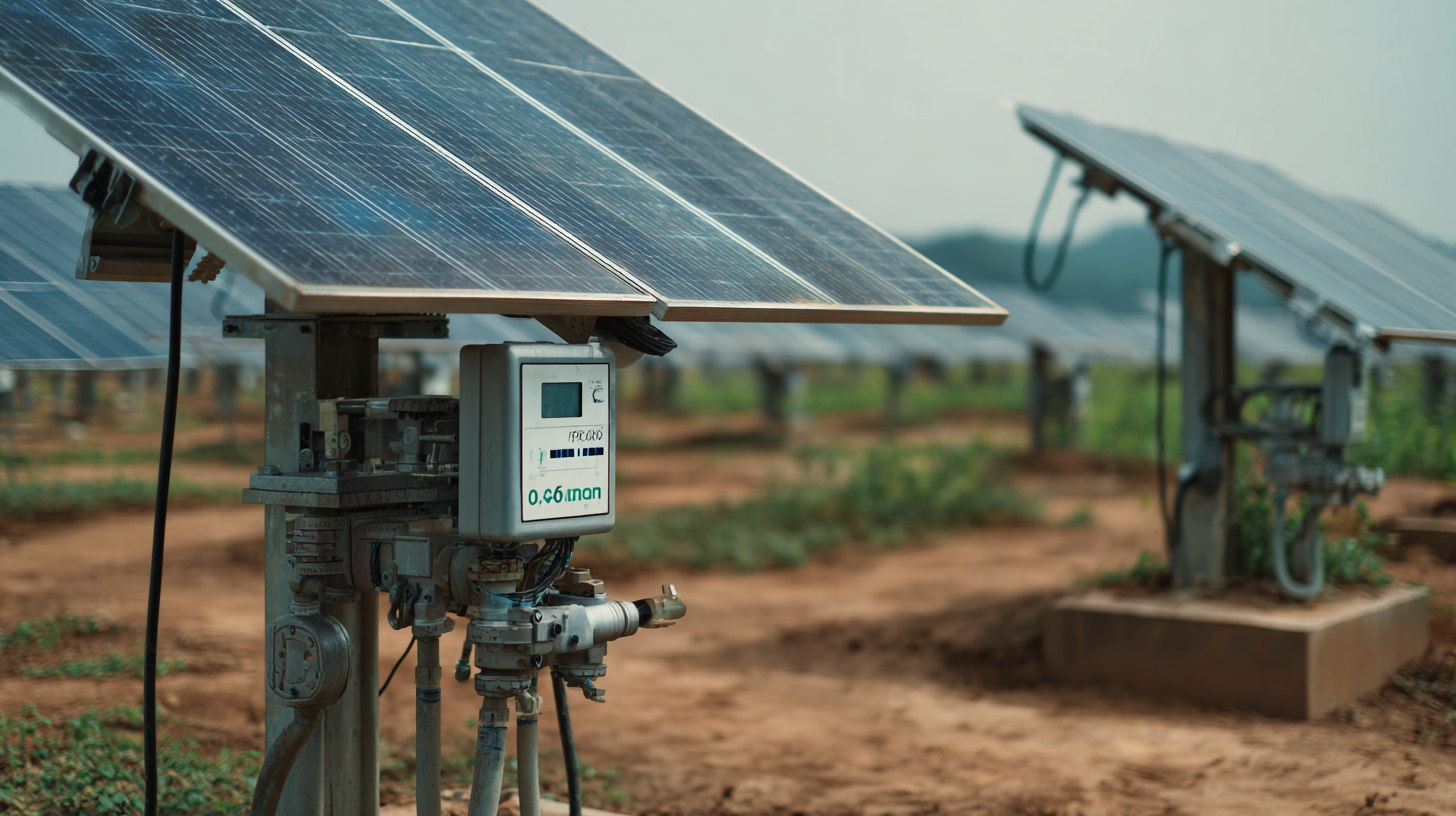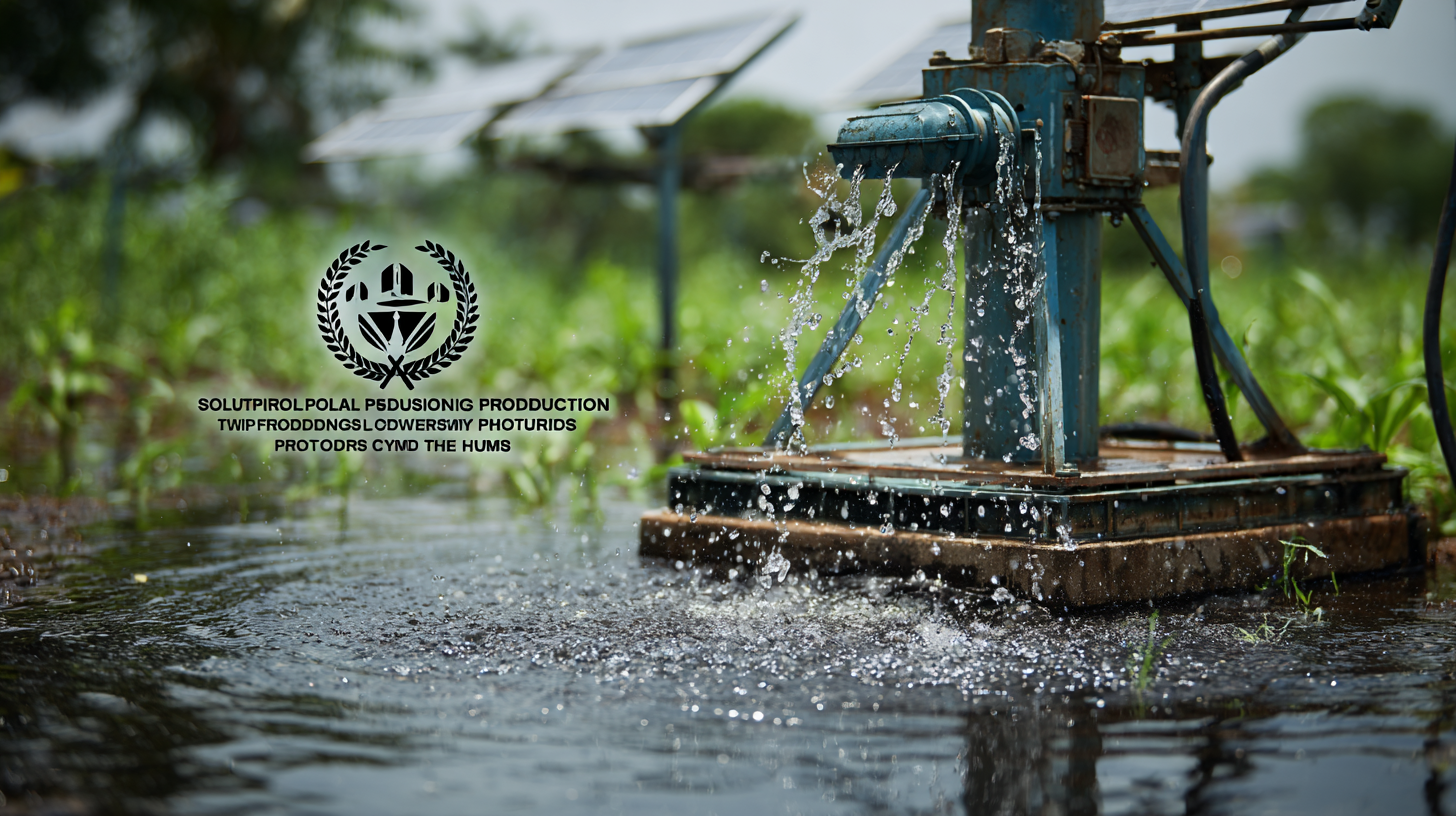Understanding Global Production Standards for the Best Solar Powered Pumps and How to Choose the Right One
As the demand for sustainable energy solutions continues to rise, Solar Powered Pumps have emerged as a revolutionary technology in agricultural and industrial applications. According to a report by the International Renewable Energy Agency (IRENA), the global market for solar pumps is projected to reach $2 billion by 2025, driven by the increasing adoption of renewable energy sources and the desire for efficient irrigation systems. However, with the expansion of this market comes the necessity to understand global production standards, as well as the importance of import and export certifications that ensure product quality and compliance. This blog aims to provide a comprehensive understanding of these standards and guide readers in choosing the right Solar Powered Pumps for their specific needs, ensuring optimal performance and sustainability.

Understanding the Importance of Global Production Standards in Solar Powered Pumps
Global production standards play a crucial role in the development and efficiency of solar-powered pumps. These standards ensure that products meet specific criteria for performance, safety, and environmental sustainability. By adhering to internationally recognized guidelines, manufacturers can enhance the reliability and longevity of their solar pumps, which is essential for users relying on these systems for irrigation, water supply, or wastewater management. The importance of these standards extends beyond compliance; they foster consumer confidence in product quality and performance.
Furthermore, understanding these global standards is key when choosing the right solar-powered pump. By familiarizing themselves with certifications and benchmarks, potential buyers can make informed decisions that align with their needs. For instance, pumps certified by reputable organizations often indicate higher efficiency rates and better energy management, which ultimately lead to cost savings over time. Awareness of these standards also facilitates comparisons between different products, allowing users to select the most suitable option for their specific applications and conditions.
Common Issues Faced with Solar Powered Pumps in Different Market Types
When it comes to solar-powered pumps, various market types can pose unique challenges that users need to navigate. For instance, according to the International Renewable Energy Agency (IRENA), the efficiency of solar pumps can heavily depend on geographic location and local climate conditions. This means that operators in regions with prolonged cloud cover often face significant performance issues compared to those in sunnier areas. Additionally, the quality of installation plays a crucial role; a study by the Department of Energy found that improperly installed systems can lead to a decrease in efficiency of up to 40%.
Another common issue in different markets is the availability of reliable maintenance services. Market research by Technavio indicates that in developing regions, the lack of skilled technicians results in prolonged downtime when repairs are needed. This not only affects the pump's output but can also lead to costly replacements if troubleshooting is neglected. Furthermore, discrepancies in local regulatory standards can complicate the adoption of solar technology, leading to confusion among users about warranty and compliance, further stifling user confidence in solar-powered solutions.
Common Issues Faced with Solar Powered Pumps in Different Market Types
Key Factors in Selecting the Right Solar Powered Pump for Your Needs
When selecting the right solar powered pump for your needs, several key factors should guide your decision. Firstly, understanding the specific water flow requirements is critical. According to a 2022 industry report, solar pumps can range from 1.5 gallons per minute (GPM) for smaller applications to over 30 GPM for larger agricultural uses. Assessing your required flow rate will ensure you choose a pump capable of meeting your demands without overspending on unnecessary capacity.

Another important aspect to consider is the pump's power source and solar panel efficiency. Research indicates that the efficiency of solar panels can vary significantly, with most high-quality panels achieving 15-20% efficiency. When selecting a pump, opt for models that come with efficient panels tailored to your geographical location to maximize energy absorption throughout the day.
Tip: Always check the compatibility of the pump with your existing solar system or consider an integrated system for seamless operation.
Additionally, consider the material and durability of the pump. A report by the International Renewable Energy Agency (IRENA) highlights that pumps made from corrosion-resistant materials can extend the lifespan significantly, especially in harsh environments. Look for pumps specifically designed for professional agricultural use if durability and long-term performance are priorities.
Tip: Regular maintenance checks on your pump can prevent minor issues from escalating and ensure its longevity, so set a schedule for routine upkeep.
Strategies for Navigating Quality Assurance in Solar Pump Production
When considering solar powered pumps, quality assurance is vital to ensure efficiency and longevity. The market today is flooded with options, but not all products meet the rigorous standards required for optimal performance. Understanding production standards is essential when selecting a solar pump; manufacturers should comply with international certification norms that guarantee reliability and performance consistency. This can significantly impact the pump’s service life and overall effectiveness in various applications, from irrigation to potable water supply.
Navigating the complex landscape of quality assurance involves establishing a set of criteria for evaluating potential suppliers. Factors such as material quality, adherence to sustainable practices, and after-sales support are crucial for making an informed decision. Moreover, as the renewable energy sector evolves, staying abreast of innovations—like hybrid energy storage systems—can provide additional insights into how solar pumps can be effectively integrated within broader energy solutions. This strategic approach not only mitigates risks but also enhances the overall sustainability of solar pump applications in a rapidly changing energy environment.
Understanding Global Production Standards for the Best Solar Powered Pumps and How to Choose the Right One - Strategies for Navigating Quality Assurance in Solar Pump Production
| Parameter | Standard Value | Measurement Unit | Importance |
|---|---|---|---|
| Pump Efficiency | 70 - 90 | Percentage (%) | Higher efficiency leads to lower energy consumption |
| Operating Voltage | 12 - 48 | Volts (V) | Determines compatibility with solar panels |
| Flow Rate | 300 - 1200 | Liters per hour (L/h) | Indicates the volume of water pumped in a given time |
| Max Head | 10 - 100 | Meters (m) | The height the pump can elevate water |
| Durability Rating | IP65 or higher | Protection Index (IP) | Resistance to dust and water |
| Warranty Period | 2 - 5 | Years | Indicates manufacturer confidence in product quality |
| Noise Level | < 50 | Decibels (dB) | Lower noise for better user experience |
The Role of Certification and Testing in Ensuring Solar Pump Reliability
 When selecting solar powered pumps, it's crucial to consider certification and testing as vital indicators of reliability. Certifications from recognized organizations ensure that the pumps meet established industry standards for performance and safety. These certifications not only guarantee the quality of the materials and components used but also the efficiency of the pump system as a whole. It's advisable to look for pumps with certifications from bodies like UL, CE, or ISO, as they reflect a commitment to maintaining high-quality production standards.
When selecting solar powered pumps, it's crucial to consider certification and testing as vital indicators of reliability. Certifications from recognized organizations ensure that the pumps meet established industry standards for performance and safety. These certifications not only guarantee the quality of the materials and components used but also the efficiency of the pump system as a whole. It's advisable to look for pumps with certifications from bodies like UL, CE, or ISO, as they reflect a commitment to maintaining high-quality production standards.
Tips: Always review the certification details provided by manufacturers. This will give you a clearer understanding of what tests the product has undergone and how it stands against potential challenges in real-world applications. Furthermore, consider reading independent test results or reviews to complement certification information.
Testing is another key aspect that contributes to a solar pump’s reliability. Rigorous testing protocols evaluate performance under various conditions, ensuring the pump can operate efficiently and withstand environmental stresses. Understanding the testing process can help in selecting a pump that offers longevity and reduced maintenance costs.
Tips: Ensure that the pump you choose has been tested for durability and performance in the specific conditions you expect to encounter. Reach out to manufacturers to inquire about their testing methods and any relevant performance data that can assist you in making an informed choice.
Contact Details
Address:
Solar Pump Solutions,
Borrisokane, Co. Tipperary, Ireland.
